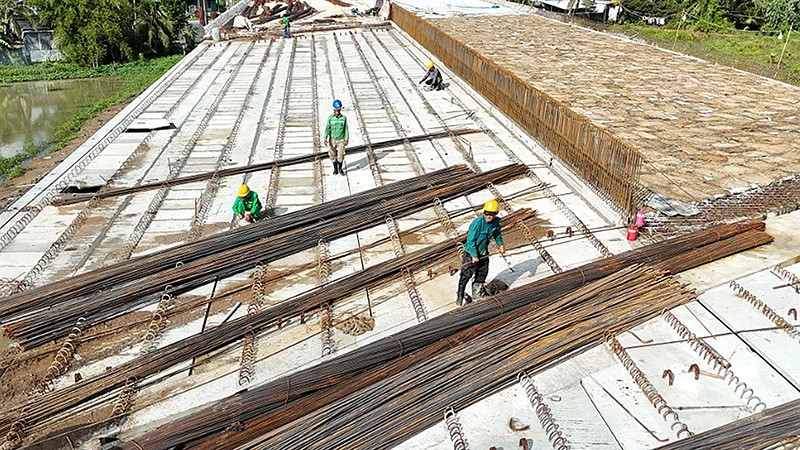A convenient transport system, with many policies to attract investment and develop businesses, has helped increase industrial value, contributing greatly to Hau Giang’s economic growth in recent years. In particular, public investment capital plays a leading role in attracting maximum resources from other economic sectors.
Interconnected transport
Hau Giang has taken advantage of many resources, from central and local budgets and loans, gradually developing a synchronous traffic infrastructure system. Thanks to that, the national highway network has increased from two routes with a length of about 80 km to six routes with a length of 158 km. All have been expanded, basically connecting Hau Giang Province with the region.
Previously, Hau Giang’s provincial road network had only seven routes with a length of about 88 km, but now it has increased to 15 routes with a length of 267 km. Currently, 51 communes in the province have car roads to the centre. In addition, more than 3,400 km of urban, commune, and rural roads have been upgraded, up nearly 15 times compared to before the province’s separation.
The density of national highways in Hau Giang Province is currently 1.46 times higher, and the density of provincial roads is 1.52 times higher than the average density of the Mekong Delta region. The widespread transport infrastructure network throughout the province has gradually met the needs of goods trading, creating a foundation and driving force for the socio-economic development of the province and the region.
Director of the Department of Transport of Hau Giang Province, Mai Van Tan, said that from 2010 to the present, the province has accelerated the construction progress and inaugurated many projects connecting with other regional provinces and cities. The road connecting Vi Thanh City with Can Tho City (phase 1) completed in May 2012 has shortened the distance from Hau Giang to Can Tho centre to 47 km, a reduction of 15 km. The Bon Tong-Mot Ngan traffic project connecting Hau Giang-Can Tho-An Giang was implemented and quickly put into use. These two traffic routes create a premise for development, becoming an economic corridor axis, connecting the regions between Hau Giang, Can Tho, Kien Giang, and An Giang. Factories, enterprises, and urban areas have been developed along these routes.
At the same time, the province invested in building the Cai Tu Bridge, connecting the two banks of Hau Giang and Kien Giang, in addition to constructing the Quan Lo-Phung Hiep route connecting Nga Bay City with Soc Trang, Bac Lieu, Ca Mau provinces. Hau Giang also prioritises investment in the provincial Road 927C project (worth nearly 1 trillion VND) connecting National Highway 1A with National Highway Nam Song Hau, linking with industrial parks along the Hau River.
To create momentum for the inter-regional development of Vi Thanh-Long My, Hau Giang invested more than 800 billion VND in the provincial Road 931B project connecting Vi Thanh City with Long My District and Hong Dan District (Bac Lieu Province).
In addition, the province upgraded provincial Road 925, connecting Chau Thanh District with National Highway 1A and National Highway Nam Song Hau, as a premise for planning Chau Thanh District as an industrial district. Some key provincial roads, such as 925B, 926B, 929, and 927, are also being implemented.
Promoting the leading role of public investment
According to the Chairman of Hau Giang Provincial People’s Committee, Dong Van Thanh, the province’s industrial parks have attracted 113 projects with a total investment capital of over 37.61 trillion VND and 617 million USD, creating jobs for more than 33,850 workers. In 2023, the industrial production value reached about 63.88 trillion VND, accounting for nearly 31.53% of the province’s economic structure. Other economic sectors also rose in value thanks to the improved transport system.
In 2023, the gross regional domestic product (GRDP) expanded by 12.27%, ranking first in the Mekong Delta region, Hau Giang's second consecutive year ranked first in the region and second in the country. In the first six months of 2024, Hau Giang’s GRDP growth reached 8.04%, ranking second in the Mekong Delta region and among the highest in the country. This result shows that public investment capital plays a leading role in developing transport infrastructure, helping attract maximum resources from other economic sectors.
A complete transport infrastructure system has been invested in industrial zones and clusters, basically meeting people's travel needs and the business development needs of enterprises. Under construction are two expressways, Can Tho-Ca Mau (vertical axis) and Chau Doc-Can Tho-Soc Trang (horizontal axis), which have sections passing through Hau Giang with a total length of about 100 km. They are considered a new development opportunity for Hau Giang and the Mekong Delta.
Hau Giang plans to have seven industrial parks with a total area of 2,200 hectares to exploit the advantages of these two expressways, according to the province’s planning for the 2021-2030 period, with a vision for 2050.
“Based on this planning, Hau Giang will continue to increase development investment resources, maximising the leading role of public investment. The allocation of public investment capital must be concentrated, especially investment in transport infrastructure connecting with national highways to create new development space and breakthrough momentum for industrial, urban, commercial and service development”, Chairman of Hau Giang Provincial People’s Committee Dong Van Thanh added.
Hau Giang is focusing on reviewing and implementing key transport projects to meet the multimodal transport needs of the local transport system, creating a foundation for the province’s socio-economic development.
















